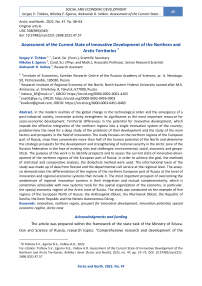Assessment of the Current State of Innovative Development of the Northern and Arctic Territories
Автор: Tishkov S.V., Egorov N.E., Volkov A.D.
Журнал: Arctic and North @arctic-and-north
Рубрика: Social and economic development
Статья в выпуске: 47, 2022 года.
Бесплатный доступ
In the modern realities of the global change in the technological order and the emergence of a post-industrial society, innovative activity strengthens its significance as the most important resource for socio-economic development. Territorial differences in the potential for innovative development, which impede the effective integration of the northern regions into a single innovation system of the country, predetermine the need for a deep study of the problems of their development and the study of the main factors and prospects in the field of innovation. The study focuses on the northern regions of the European part of Russia, since they concentrate more than half of the human potential of the North and determine the strategic prospects for the development and strengthening of national security in the Arctic zone of the Russian Federation in the face of existing risks and challenges: environmental, social, economic and geopolitical. The purpose of this work is to identify prospects and to assess the current state of innovative development of the northern regions of the European part of Russia. In order to achieve the goal, the methods of statistical and comparative analysis, the dialectical method were used. The informational basis of the study was made up of data from Rosstat and the departmental civil service at the regional level. The analysis demonstrates the differentiation of the regions of the northern European part of Russia at the level of innovation and regional economic systems that include it. The most important prospect of overcoming the weaknesses of regional innovation systems is their integration and mutual complementarity, which is sometimes achievable with new systemic tools for the spatial organization of the economy, in particular, the special economic regime of the Arctic zone of Russia. The study was conducted on the example of five regions of the European North of Russia: the Arkhangelsk Oblast, the Murmansk Oblast, the Republic of Karelia, the Komi Republic and the Nenets Autonomous Okrug.
Innovation, northern region, prospect for innovative development, innovation potential, special economic regime, Arctic zone
Короткий адрес: https://sciup.org/148324397
IDR: 148324397 | УДК: 338(985)(045) | DOI: 10.37482/issn2221-2698.2022.47.57
Текст научной статьи Assessment of the Current State of Innovative Development of the Northern and Arctic Territories
Innovative development of the Russian economy is constrained by the unresolved problems related to its structural features, technological dependence on foreign enterprises, including critical sectors of the economy, and a set of infrastructural, socio-demographic, legal, financial and informational challenges. One of the key unresolved problems is the low innovation activity and limited innovative potential of many northern regions, caused by the implementation of the above-mentioned set of challenges. Over the last 15 years, the level of innovation activity and potential has fluctuated markedly, there was a decrease in indicators in the early 2000s, stabilization and a decline again.
The structure of the economy of the Russian Federation, especially the Arctic zone, has changed significantly over the past 15 years, with an increase in the share of some industries and their influence on the existing model of the Russian economy development, and a decrease in the share of others. However, a significant role played by the northern and Arctic territories in the development of the country’s economy [1, Tsukerman V.A., Goryachevskaya E.S.], continues to be in a de facto resource-oriented and depleting model of exploitation of natural potential [2, Gritsenko D., Efimova E.]. During the same period, transformational processes took place in the world economy that determined the features of the new way of life: “energy transition” from fossil energy sources to renewable ones [3, Escribano G.], ecologization and introduction of appropriate measures of tax and customs incentives [4], transition to Industry 4.0 and 5.0 economies [5, Kurt R.; 6, Fukuda K.; 7, Bessonova E., Battalov R.; 8, Klóska R.]. Gaining strength, these processes accelerate the exhaustion of prospects for further preservation of the resource-oriented development model of the Russian economy, including social and political aspects [9, Agyekum E.B.; 10, Romanova T.]. In addition, sanctions pressure has a major impact [11, Shapovalova D., Galimullin E., Grushevenko E.]. Taken together, these internal and external circumstances form the urgent challenges to Russia’s economic development, making it necessary to activate its innovation potential and find a new model of development of the northern regions [12, Plotnikova T.N., Kon-yakhina T.B., Solomonova E.B.; 13, Kookueva V., Tsertseil Y.].
Specifics of the northern regions as a research object
The northern regions are important for the development of the country, primarily for meeting its needs for natural resources. They provide 100% of the demand for apatite concentrate, from 40% to 100% of the reserves of gold, oil, natural gas, chromium and manganese, platinum and diamonds are concentrated in the North [14, Tatarkin A.I., Loginov V.G.; 15, Lazhentsev
V.N.]. A significant part of these resources is concentrated in the Arctic zone. Murmansk and Arkhangelsk oblasts, Karelia and Komi republics are fully or partially included in the Arctic zone of the European part of the Russian Federation [16, Druzhinin P.V., Potasheva O.V.].
However, the Arctic zone of Russia at the present stage of development is characterized by a tendency to exhaust resources for the reproduction of the regional socio-economic system within the framework of the previously existing raw material reproduction model. This reflects a large and, in some territories, critical accumulated environmental damage from economic activities, low energy efficiency of the economy, negative demographic dynamics and erosion of the settlement system established at the previous stage of the Arctic development, a significant degree of depletion of explored and developed deposits of strategic resources. Within the framework of the article, major challenges are considered as a system of technological, resource and environmental constraints, as well as emerging geopolitical risks.
The northern regions included in the NWFO have a number of specific features and many prerequisites for scientific and innovative development. These features include:
-
• favourable geographical position, including a cross-border location;
-
• special climatic factors, resulting in harsh natural conditions, limited activity of the population, heating costs, construction of buildings with thermal insulation, high energy costs for production, etc.;
-
• development of transport and logistics routes (Northern Sea Route, port infrastructure, icebreaking fleet, offshore mining);
-
• predominance of resource-extracting industries in the regional economy [17, Rumyantsev A.A.; 18, Mikhailov A.S., Gorochnaya V.V., Mikhailova A.A., Plotnikova A.P., Volkhin D.A. ];
-
• population decline from 20 to 40% over the past decades;
-
• dependence on the supply of food, fuel and various products;
-
• high material consumption of manufactured products [19, Druzhinin P.V.];
-
• “Northern rise in prices” and high costs of maintaining the territories, which determine the low level of human capital development and low innovative activity [20, Naberezhnaya A.T.; 21, Glukhov V.V., Detter G.F., Tukkel I.L.].
Research methodology and information base
When analyzing the innovative development of the northern territories of the European part of Russia, the authors used the methods of statistical and comparative analysis, the dialectical method. Information sources of the study include official statistical information, as well as data from government services and departments.
The methodology for ranking the innovative development of regions (IDR) is based on the methodology of the Institute for Statistical Studies and Economics of Knowledge of the National
Research University Higher School of Economics (NRU HSE) 1. The rating of innovative development of the constituent entities of the Russian Federation is based on ordering them by decreasing values of the consolidated innovation index — the Russian Regional Innovation Index (RRII). It is formed on the basis of 53 indicators grouped into 16 sections and distributed into five thematic blocks. The final RRII value is determined as the arithmetic average of normalized values of all indicators included in the rating.
The main key indicators given in the official statistical collections of Rosstat 2 and Rospatent
Key indicators of innovative development of the Northern Regions of the NWFO
-
3, as well as in the materials of NIAC MIIRIS 4, can be used for comparative analysis and dynamics of the level of innovation potential of the regions (Table 1).
Table 1
|
Designation |
Name of indicator |
|
I 1 |
The level of innovation activity of organizations, %. |
|
I 2 |
The share of people engaged in research and development per 10000 of the average annual number of people employed in the economy of the region, %. |
|
I 3 |
t he share of internal research and development costs to g ross r egional p roduct (grp), %. |
|
I 4 |
The share of innovation activity costs in the total volume of goods shipped, works performed, services, %. |
|
I 5 |
The number of patents granted for inventions, utility models and industrial designs per 10000 of the workforce, units. |
|
I 6 |
The volume of innovative goods, works, services in the total volume of goods shipped, works performed, services, %. |
|
I 7 |
The share of budget funds in internal research and development costs, %. |
For ease of perception and interpretation of the assessment results, numerical calculations are performed on the basis of normalized average values of the key indicators of regional IDR, which are given in a comparable form in the range from 0 to 1. At that, 1 point characterizes the subject as a leader, and 0 points — as an absolute outsider [22, Bobylev N.G., Gadal Sebastien, Konovalova M.O., Sergunin A.A., Tronin A.A., Tyunkynen Veli-Pekka].
Empirical results of the study
The result of the rating assessment of the NWFO regions according to the RRII for 2018/2019, normalized to 1 relative to the value of the leading subject of the Russian Federation (in this case, Moscow), is shown in figure 1.
|
Subject-leader |
1,00 |
|
Arkhangelsk Region Murmansk Region Komi Republic Karelia Republic Nenets Autonomous Area |
0,630 0,608 0,605 0,590 0,281 |
Fig. 1. Rating of the IDR level in 2018/2019.
As the rating results show, all regions, except for the Nenets Autonomous Okrug, have comparable RRII values (0.59–0.63). Table 2 shows the IDR levels by the difference between the values of RRII from the value of the leading subject in the Russian Federation.
Table 2
Estimated IDR level in 2018/2019 5
|
Regions |
The difference between the average values of the RRII from the leader, % |
IDR level |
|
Subject-leader |
0.0 |
high |
|
Murmansk Oblast |
39.2 |
medium |
|
Karelia Republic |
41.0 |
low |
|
Arkhangelsk Oblast |
37.0 |
medium |
|
Komi Republic |
39.5 |
medium |
|
Nenets Autonomous Okrug |
71.9 |
extremely low |
Analysis of the table 2 shows that there are no entities among the northern regions of the NWFO with a high level of innovative development, which includes the regions lagging behind the IDR values from the result of the leading subject less than 20%. The average level of IDR (20–40%) is in the Murmansk Oblast, the Arkhangelsk Oblast and the Komi Republic. Low (40–60%) and extremely low (>60%) levels are shown by the Republic of Karelia and the Nenets Autonomous Okrug, respectively.
Analysis of comparison of the IDR dynamics over 10 years showed different rates of growth in the level of indicators in 2019 compared to 2010 (Table 3). For example, three subjects of the NWFO (Arkhangelsk Oblast, Komi Republic, Nenets Autonomous Okrug) show a significant increase in funding for research and development at the expense of regional budgets in 2019 (indicator I 7 ), which characterizes the attention and support of local authorities for the innovative development of the region’s economy.
Table 3
The rate of increase/decrease in the IDR indicators of the regions for 2019/2010, % 6
|
Northern regions of the NWFD |
I 1 |
I 2 |
I 3 |
I 4 |
I 5 |
I 6 |
I 7 |
|
Murmansk Oblast |
-0.1 |
0.06 |
-0.4 |
-1.18 |
-0.50 |
2.3 |
3.0 |
|
Karelia Republic |
0.5 |
0.14 |
-0.1 |
-0.78 |
2.02 |
0.9 |
-13.2 |
|
Arkhangelsk Oblast |
5.3 |
0.01 |
-0.05 |
0.3 |
0.74 |
3.9 |
16.4 |
5 Source: compiled by the authors based on HSE data.
6 Source: compiled by the authors.
|
Komi Republic |
-0.3 |
0.0 |
-0.2 |
0.5 |
0.8 |
-1.6 |
19.2 |
|
Nenets Autonomous Okrug |
-2.6 |
-0.2 |
0.0 |
0.0 |
0.0 |
-0.4 |
18.6 |
Innovative activity of the regions (I 1 ) over the period under review is developing unstably:
in 2019, the Arkhangelsk Oblast occupies the leading position in this indicator, with a growth rate of 5.3% over 10 years (Table 2). The rest of the regions, except for Karelia, show a decrease in the level of innovation activity (Fig. 2).
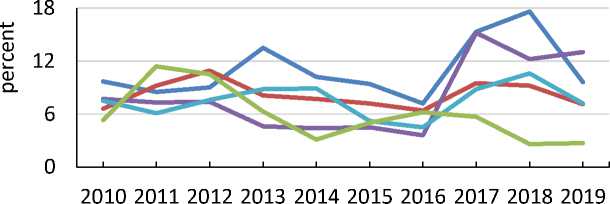
г Murmansk Region ^^^^^™ Karelia Republic г Arkhangelsk Region ^^^^^™Komi Republic
Nenets Autonomous Area
Fig. 2. Dynamics of the level of innovation activity of the NWFO regions.
Availability and professionalism of people engaged in research and development have the main influence on the effectiveness of innovation activity. This indicator is relatively stable in the regions, except for the Nenets Autonomous Okrug due to the small population compared to other subjects (Fig. 3). It should be noted that the Nenets Autonomous Okrug has practically no regulatory framework for innovation, including the absence of an independent innovation strategy [23, Egorov N.E., Kovrov G.S.].
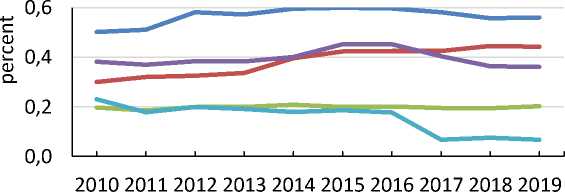
Murmansk Region ^^^^^м Karelia Republic
Arkhangelsk Region ^^^^^м Komi Republic
^^^^^™ Nenets Autonomous Area
Fig. 3. Dynamics of the proportion of people engaged in research and development per 10 000 average annual number of people employed in the economy of the region.
The indicator of the share of internal expenditures on research and development to the gross regional product (GRP) is one of the main planning indicators included in most regulatory legal acts on the socio-economic development of the constituent entities of the Russian Federation. Regional authorities should pay special attention to this indicator, as in recent years there has been a steady decline in its level in the NWFO subjects (Fig. 4).

с Murmansk Region с Karelia Republic
Arkhangelsk Region
Fig. 4. Dynamics of the share of internal expenditures on research and development to GRP.
The value of expenditures on innovation activities, which characterizes the actual expenditures of an organization that are mainly directed to the development and implementation of technological innovations, is important for the development of the innovation economy. The Republic of Karelia (1.8%) has high indicators by this criterion in 2019 with a wide margin over other regions, although it has consistently had low values in the dynamics of its development. In 2011– 2012, the Republic of Komi, the Arkhangelsk Oblast and the Nenets Autonomous Okrug have high values of organizations’ expenditures on innovation activities (Fig. 5).

2010 2011 2012 2013 2014 2015 2016 2017 2018 2019
^^^^^^ Murmansk Region с Karelia Republic
^^^^^^Arkhangelsk Region с Komi Republic
^^^^^^ Nenets Autonomous Area
Fig. 5. Dynamics of the share of innovation activity costs from the total volume of goods shipped, works performed, services.
Patent statistics is the main indicator of the effectiveness of innovation activity and one of the key indicators of the technological development of countries and regions [24]. Generally, the coefficient, defined as the number of invention applications submitted by domestic applicants to the patent office of the country per 10 000 people, is used to assess the inventive activity of the population. Since the intellectual abilities of a person to work are most manifested at the age of 15 to 72 years (economically active population), it is advisable to use the number of labor force (LF) given in the annual statistical collections of Rosstat in the calculation.
In terms of the number of patents issued for inventions, utility models and industrial designs per 10 000 LF, the Republic of Karelia occupies the leading position among the northern regions of the NWFO in 2019 and in 10 years as a whole (Fig. 6). As can be seen from the above chart, the dynamics of issued patents in the regions shows a positive trend.

Murmansk Region ^^^^^м Karelia Republic
^^^^^^Arkhangelsk Region с Komi Republic
^^^^^^Nenets Autonomous Area
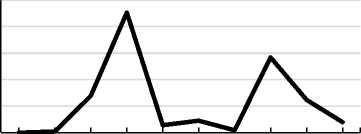


Fig. 6. Dynamics of the number of patents granted for inventions, utility models and industrial designs per 10000 labor force.
The main key indicator characterizing the final result (efficiency) of innovative activity is the volume of innovative products produced. According to this indicator, the Arkhangelsk Oblast shows significantly high values among the northern regions of the NWFD (in this regard, the graph is presented separately, Fig. 7). However, according to 2019 data, the first place is occupied by the Murmansk Oblast (4.7%), in which the volume of innovative products in the total volume of shipped goods increased by 5.9 times compared to the previous year. It should be noted that in 2019 the indicator in the Republic of Komi decreased by 4.9 times compared to 2011, when the highest peak of its level (7.8%) was observed.
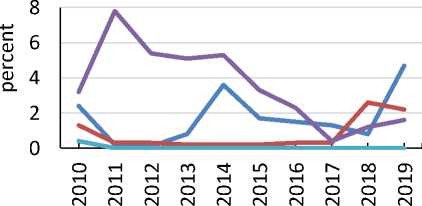
r Murmansk Region
^^^^^^Karelia Republic
^^^^^»Komi Republic
^^^^^wNenets Autonomous Area
^^^^^™Arkhangelsk Region
Fig. 7. Dynamics of the volume of innovative goods, works, services in the total volume of goods shipped, works performed in 2010–2019.
The main indicator reflecting the assistance and support of the regional authorities to the development of an innovative economy is the allocation of funding for scientific research and applied developments from the local budget through the relevant regional programs. Since funding is allocated to specific organizations that carry out research and development and have their own internal costs for innovation, the amount of budget funds depends on the number of these organizations, 32 of which are in the Nenets Autonomous Okrug, so this ratio is higher there than in other subjects (Fig. 8). The trend of increasing budget funding in the Komi Republic over the past 3 years (2017–2019) by 28.4% with the number of organizations (25–27 units) should be noted.

^^^^^™Murmansk Region ^^^^^м Karelia Republic
^^^^^^*Arkhangelsk Region ^^^^^ Komi Republic
Nenets Autonomous Area
Fig. 8. Dynamics of the share of budget funds in internal research and development costs in 2010–2019.
In order to identify and analyze the strengths and weaknesses of the IDR, an innovative profile in the form of a petal histogram is used (Fig. 9). Red color indicates the distribution of normalized average values of key IDR indicators for the NWFO macroregion for 2019. As can be seen from Fig. 9a, the Murmansk Oblast has a high level (value 1.0) of R&D employment per 10,000 average annual number of people employed in the regional economy (indicator I 2 ), the share of domestic costs for research and development to GRP (I 3 ) and the volume of innovative goods, works, services in the total volume of shipped goods, performed works, services (I 6 ). In general, apart from indicators I 4 and I 5 , the innovative potential of the region is higher than the average for the considered macroregion.
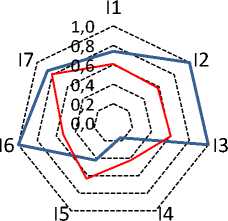
a)
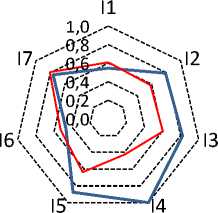
b)
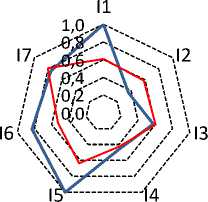
c)
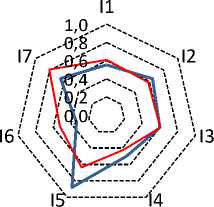
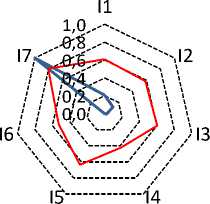
d) e)
Fig. 9. Innovation profiles of the northern regions of the NWFO in 2019: a) Murmansk Oblast; b) Karelia Republic; c) Arkhangelsk Oblast; d) Komi Republic; e) Nenets Autonomous Okrug.
The level of innovation development in the Komi Republic almost coincides with the average level in the macroregion (Fig. 9d), but differs by the large number of issued patents for inventions, utility models and industrial designs per ten thousand LF (I 5 = 0.9). As can be seen from fig. 9c, the maximum value of this indicator belongs to the Arkhangelsk Oblast. The Nenets Autonomous Okrug, as an outsider in the macroregion, has a low innovation potential, although the regional authorities make certain efforts to support innovation financially (I 7 ), which, as usual, appear after a certain time lag. Thus, the research results confirm the fact that there is a significant difference in the level of innovation development between the regions of the Far North of the Russian Federation [25, Egorov N.E., Kovrov G.S.].
Prospects for innovative development of the northern regions based on the creation of industrial and technological parks
Technopark structures are created to provide a range of services for investors when locating innovative business in a region. Today, there are 80 technoparks in Russia, 36 of them are functioning. Most of the parks (31) were created after 2006. They have already accommodated 958 resident companies and created 56 thousand jobs. The largest parks employ between 5 000 and 7 000 people. Technoparks have been created in 33 subjects of the Russian Federation [26, Tishkov S.V.; 27, Tretyakova E.A., Noskov A.A.].
The vast majority of the technoparks are private (34 out of 36 operating parks). In contrast, the parks under development are characterised by a higher share of state parks and parks established as public-private partnerships. The interest of the state in technoparks as a tool for attracting investments is associated with the high efficiency demonstrated by the private parks. Moreover, in those regions where technoparks have already been created and are functioning, new ones are being designed. Only 14 of 44 technological parks being designed today, are the first in their regions.
Today, there is a tendency to reduce the area of technoparks, which minimizes investment risks. Brownfield parks are characterized by higher fillability rate due to the increased demand for
SOCIAL AND ECONOMIC DEVELOPMENT
Sergey V. Tishkov, Nikolay E. Egorov, Aleksandr D. Volkov. Assessment of the Current State… ready-to-use production space from small companies in recent years. The average number of residents for Greenfield parks is 11, for Brownfield projects — 51.
In terms of industry, technoparks represent a fairly wide range of sectors, with mechanical engineering, automotive, chemicals and metallurgy, woodworking and construction materials predominating. As a rule, the park also houses companies whose business is focused on the needs of other residents of this technopark. A high concentration of resident companies can be a factor in the formation of a cluster.
Generally, technological parks are only one of the instruments of investment and innovation policy [10, Romanova T.; 28, Ivanova I., Strand O., Leidesdorff L.]. Northern regions have a number of technoparks of various forms of ownership. The list of operating parks is presented in Table 4.
Table 4
Operating technoparks of the northern regions of the North-West of Russia 7
|
Region |
Name of the technopark |
Technopark status |
Type of technopark |
Form of ownership |
|
Arkhangelsk Oblast |
“Shies” |
Intentions |
Greenfield |
State |
|
Murmansk Oblast |
“TECHNOPARK-NOR AS” |
current |
Greenfield |
Private |
|
Murmansk Oblast |
“Quantorium 51” |
current |
Brownfield |
State |
|
Karelia Republic |
“Technograd PetrSU” |
current |
Brownfield |
State |
|
Komi Republic |
“Quantorium” |
current |
Brownfield |
State |
|
Komi Republic |
“The City of the Future” |
current |
Brownfield |
State |
Five technological park, mostly state-owned, have been created and are operating in the northern regions. There are plans to create a technopark in the Arkhangelsk Oblast. The type of technological parks is predominantly Brownfield, which means that they are built on old areas.
The main problem in the formation and development of techno-practical structures, as cited by researchers N.I. Komkov and V.A. Zuckerman, is the lack of effectiveness of state regulation, for example, the abundance of tools leads to the fact that they duplicate each other, making it difficult for enterprises to use them [29; 30; 31].
In the case of attracting a large “anchor” investor interested in large industrial areas, it may be a Greenfield Park. Typically, the location of such parks is conditioned either by the proximity of the sales market or by the availability of necessary resources (labor or natural). If there is one, the location and conditions for the establishment of a technopark will be determined by its individual requirements for the investment site. Attracting an “anchor” investor requires a detailed assessment of the region's competitive advantages and an analysis of innovative product markets, which can be carried out as part of the preparation of a regional innovation development strategy.
The possibility of creating technoparks in northern cities is due to the trend of releasing production space on the territory of city-forming enterprises. At the same time, the city-forming enterprise itself can act as the founder of the technopark management company, providing itself
-
7 Source: compiled by the authors.
with an additional source of income. The emergence of new production facilities for the northern regions will diversify the local economy and provide employment for the population.
A technopark focused on small and medium-sized innovative enterprises can perform (if necessary) the functions of a business incubator and its management company could function as a consulting centre. A shared-use centre may be created as part of this option, providing access to the most in-demand manufacturing equipment. If a technopark of a certain specialization is created (for example, the production of building materials), the management company can promote the products of resident companies in the markets.
Conclusion
Dependence on raw materials and low level of innovative development determine a system of restrictions and risks for the development of the vast northern and border areas of the Russian Arctic, which, for all its colossal strategic importance, is a problematic periphery.
The current development strategies (both regional and federal) do not contain a holistic vision of the driving forces of spatial and innovative development, do not fully reflect geopolitical and geoeconomic aspects, and do not have the necessary development of implementation tools. This distorts managerial decisions, leaving both global trends and deep contradictions of internal development without attention.
The need to form a new economic and legal regime in the Arctic requires the intensification of research work in the field of both information and analytical preparation of managerial decisions, and justification of a new paradigm of regional development. At the same time, it is extremely important to develop transitional socio-economic mechanisms that allow the transfer to a new development paradigm, the formation of which is witnessed today, without damaging the ecological systems and society of the Arctic and with maximum economic effect both in the short and long term. Taking into account the experience of the development of the Arctic regions of Russia and foreign countries, it can be reasonably assumed that such promising areas are:
-
• creation of innovative industrial clusters based on promising mineral resource centers (MRCs) and existing production facilities;
-
• creation of tourism clusters based on the strengthening and integration of the infrastructure of existing and prospective tourist destinations;
-
• development of the biofuel sector (biodiesel, biogas) working in cooperation with the innovation clusters (for example, biotechnology cluster and aquaculture cluster).
The principle provision in the formation of a transitional development model is reduction of the burden on the environment, energy saving and decline in the accumulated environmental damage to the Arctic ecosystems.
The main proposals for improving the innovative development of the Northern regions have been developed as part of the study:
-
• improving the tools for collecting, processing and analyzing information on the socioeconomic development of the region of the Arctic zone of Russia based on the use of interdisciplinary methods, including the use of advanced computer and network technologies of crowdsourcing and communication planning;
-
• identification of relevant parameters of socio-economic dynamics, scenarios for innovative development of the Arctic zone of Russia in the context of technological, resource, environmental constraints and geopolitical risks;
-
• development of fundamental theoretical provisions that systematically substantiate a fundamentally new stage in the formation of the socio-economic architecture of the Arctic zone of Russia. Development of these provisions in the relevant internal and external challenges tools for substantiating and developing management decisions, forecasting socio-economic development in conditions of high uncertainty of a number of environmental parameters;
-
• development of models and mechanisms for the transitional stage of the development of the Arctic zone, based on the activation of the innovative component of the economy, while simultaneously activating mechanisms to reduce the burden on the environment, save energy and reduce the accumulated environmental damage to the ecosystems of the Arctic;
-
• formation of a new information resource, characterized by the completeness, reliability and relevance of the information provided, corresponding to the new management agenda, implementation of tasks at a qualitatively new level due to innovative means of their justification;
-
• development of analytical bases for improving the regulatory and legal framework of the new economic and legal regime of the Arctic zone of the Russian Federation at the federal and regional levels.
Список литературы Assessment of the Current State of Innovative Development of the Northern and Arctic Territories
- Tsukerman V.A., Goryachevskaya E.S. Geoekonomicheskaya strategiya Rossii v Arktike [Geo-Economic Strategy of Russia in the Arctic]. Sever i rynok: formirovanie ekonomicheskogo poryadka [The North and the Market: Forming the Economic Order], 2015, no. 1 (44), pp. 115–122.
- Gritsenko D., Efimova E. Is There Arctic Resource Curse? Evidence from the Russian Arctic Regions. Resources Policy, 2020, vol. 65. 101547. DOI: 10.1016/j.resourpol.2019.101547
- Escribano G. Beyond Energy Independence: The Geopolitical Externalities of Renewables. In: Handbook of Energy Economics and Policy Fundamentals and Applications for Engineers and Energy Planners. Chapter 13. Academic Press, 2021, pp. 549–576. DOI: 10.1016/B978-0-12-814712-2.00013-0
- Johnson C. et al. The Bio-Based Industries Joint Undertaking as a Catalyst for a Green Transition in Europe under the European Green Deal. EFB Bioeconomy Journal, 2021, vol. 1. 100014. DOI: 10.1016/j.bioeco.2021.100014
- Kurt R. Industry 4.0 in Terms of Industrial Relations and Its Impacts on Labour Life. Procedia Com-puter Science, 2019, vol. 158, pp. 590–601. DOI: 10.1016/j.procs.2019.09.093
- Fukuda K. Science, Technology and Innovation Ecosystem Transformation toward Society 5.0. Inter-national Journal of Production Economics, 2019, vol. 220. 107460. DOI: 10.1016/j.ijpe.2019.07.033
- Bessonova E., Battalov R. Digitalization as a Tool for Innovative Economic Development. Economic Annals-XXI, 2020, vol. 186 (11–12), pp. 66–74. DOI: 10.21003/ea.V186-08
- Klóska R. Proinnovative Regional Development in Poland as a Criterion for Cluster Analysis. Geogra-phy, 2018, no. 129, pp. 143–151. DOI: 10.18276/epu.2018.129-12
- Agyekum E.B. et al. Decarbonize Russia — A Best-Worst Method Approach for Assessing the Renewable Energy Potentials, Opportunities and Challenges. Energy Reports, 2021, vol. 7, pp. 4498–4515. DOI: 10.1016/j.egyr.2021.07.039
- Romanova T. Russia's Political Discourse on the EU’s Energy Transition (2014–2019) and Its Effect on EU-Russia Energy Relations. Energy Policy, 2021, vol. 154. 112309. DOI: 10.1016/j.enpol.2021.112309
- Shapovalova D., Galimullin E., Grushevenko E. Russian Arctic Offshore Petroleum Governance: The Effects of Western Sanctions and Outlook for Northern Development. Energy Policy, 2020, vol. 146. 111753. DOI: 10.1016/j.enpol.2020.111753
- Plotnikova T.N., Konyakhina T.B., Solomonova E.B. Indikativnaya otsenka innovatsionnoy vospriim-chivosti regiona [Indicative Estimates Innovative Susceptibility Region]. Fundamental'nye issledo-vaniya [Fundamental Research], 2015, no. 12 (1), pp. 181–186.
- Kookueva V.V., Tsertseil J.S. Clustering as a Basis for an Innovative Development Strategy. European Research Studies Journal, 2018, no. 4 (21), pp. 818–830. DOI: 10.35808/ersj/1249
- Tatarkin A.I., Loginov V.G. Otsenka prirodno-resursnogo i proizvodstvennogo potentsiala severnykh i arkticheskikh rayonov: sostoyanie i perspektivy ispol'zovaniya [Estimation of Potential for Natural Resources and Production in Northern and Arctic Areas: Conditions and Prospects for Use]. Studies on Russian Economic Development, 2015, vol. 26, no. 1, pp. 22–31.
- Lazhentsev V.N. Sever Rossii: al'ternativy na budushchee [North of Russia: Alternatives for the Fu-ture]. Sovremennye proizvoditel'nye sily [Modern Productive Forces], 2013, no. 2, pp. 115–124.
- Druzhinin P.V., Potasheva O.V. Rol' innovatsiy v razvitii ekonomiki severnykh i arkticheskikh terri-toriy [The Role of Innovation in the Economic Development of the Northern and Arctic Regions]. Arktika: ekologiya i ekonomika [Arctic: Ecology and Economy], 2019, no. 3 (35), pp. 4–15. DOI: 10.25283/2223-4594-2019-3-4-15
- Rumyantsev A.A. Investitsii v innovatsii i v osnovnoy kapital vo vremennom aspekte v regionakh Severo-Zapada Rossii [Investments in Innovation and Fixed Capital in the Regions of Northwest Rus-sia in Terms of Time]. Studies on Russian Economic Development, 2021, vol. 32, no. 1, pp. 98–102. DOI: 10.47711/0868-6351-184-145-151
- Mikhaylov A.S., Gorochnaya V.V., Mikhaylova A.A., Plotnikova A.P., Volkhin D.A. Klastery Primor-skikh regionov Evropeyskoy chasti Rossii [Clusters in the Coastal Regions of the European Part of Russia]. Geograficheskiy vestnik [Geographical Bulletin], 2020, no. 4 (55), pp. 81–96. DOI: 10.17072/2079-7877-2020-4-81-96
- Druzhinin P.V. Problemy innovatsionnogo razvitiya predpriyatiy prigranichnoy Karelii [Problems of Innovative Development of Enterprises in Border Karelia]. Sever i rynok: formirovanie ekonomich-eskogo poryadka, 2008, no. 2 (21), pp. 103–107.
- Naberezhnaya A.T. Regional'nye faktory udorozhaniya stoimosti zhizni naseleniya na Severe [Re-gional Factors Increasing the Cost of Living of the Population in the North]. Regional'naya ekonomi-ka: teoriya i praktika [Regional Economics: Theory and Practice], 2013, no. 25, pp. 51–55.
- Glukhov V.V., Detter G.F., Tukkel I.L. Sozdanie regional'noy innovatsionnoy sistemy v usloviyakh Ark-ticheskoy zony Rossiyskoy Federatsii: proektirovanie i opyt realizatsii [The Creation of a Regional In-novation System in the Arctic Zone of Russian Federation: Design and Implementation Experience]. Innovatsii [Innovations], 2015, no. 5, pp. 86–98.
- Bobylev N.G., Gadal S., Konovalova M.O., Sergunin A.A., Tronin A.A., Tynkkynen V.-P. Ranzhirovanie regionov arkticheskoy zony Rossiyskoy Federatsii po indeksu ekologicheskoy bezopasnosti [Regional Ranking of the Arctic Zone of the Russian Federation on the Basis of the Environmental Security Index]. Sever i rynok: formirovanie ekonomicheskogo poryadka, 2020, no. 3 (69), pp. 17–40. DOI: 10.37614/2220-802X.2.2020.69.002
- Egorov N.E., Kovrov G.S. Innovatsionnoe razvitie severnykh regionov resursnogo tipa [Innovative Development of the Northern Regions of the Resource Type]. Innovatsii [Innovations], 2021, no. 1 (267), pp. 68–78. DOI: 10.26310/2071-3010.2021.267.1.010
- Domnich E.L. Patentnaya statistika kak izmeritel' ekonomiki nauki i innovatsiy v regionakh Rossii [Patent Statistics as a Measuring Instrument for Science and Innovation Economy in Russian Re-gions]. Innovatsii [Innovations], 2013, no. 5, pp. 92–95.
- Egorov N.E., Kovrov G.S. Comparative Assessment of Innovative Development of the Far North Re-gions. Arctic and North, 2020, no. 41, pp. 62–74. DOI: 10.37482/issn2221-2698.2020.41.62
- Tishkov S.V. Formirovanie i razvitie regional'noy innovatsionnoy sistemy regionov Severo-Zapada Rossii: problemy i perspektivy [Formation and Development Regional Innovation System Regional Systems North-West of Russia: Problems and Prospects]. Moscow, Pervoe ekonomicheskoe iz-datelstvo Publ., 2021, 190 p. DOI: 10.18334/9785912923739 (In Russ.)
- Tretyakova E.A., Noskov A.A. Innovatsionnaya deyatel'nost' regionov Severo-Zapadnogo feder-al'nogo okruga: sopostavitel'nyy otsenochnyy analiz [Innovation Performance of Russia's North-western Regions: A Comparative Evaluation]. Baltiyskiy region [Baltic Region], 2021, vol. 13, no. 1, pp. 4–22. DOI: 10.5922/2079-8555-2021-1-1
- Ivanova I., Strand O., Leydesdorff L. Sinergiya i tsiklichnost' regional'nykh innovatsionnykh sistem: primer Norvegii [The Synergy and Cycle Values in Regional Innovation Systems: The Case of Nor-way]. Forsayt [Foresight and STI Governance], 2019, vol. 13, no. 1, pp. 48–61. DOI: 10.17323/2500-2597.2019.1.48.61
- Komkov N.I., Selin V.S., Tsukerman V.A., Goryachevskaya E.S. Problemy i perspektivy innovatsion-nogo razvitiya promyshlennogo kompleksa rossiyskoy Arktiki [Problems and Perspectives of Innova-tive Development of the Industrial System in Russian Arctic Regions]. Studies on Russian Economic Development, 2017, no. 1 (160), pp. 41–49.
- Komkov N.I., Tsukerman V.A., Goryachevskaya E.S. Analiz osnovnykh faktorov innovatsionnogo razvitiya regionov Arkticheskoy zony RF [Analysis of the Main Factors of Innovative Development of the Arctic Regions of Russia]. Studies on Russian Economic Development, 2019, no. 1 (172), pp. 33–40.
- Tsukerman V.A., Goryachevskaya E.S. Otsenka differentsiatsii innovatsionnogo razvitiya Arktich-eskikh regionov [Assessment of the Differentiation of Innovative Development of the Arctic Re-gions]. Sever i rynok: formirovanie ekonomicheskogo poryadka, 2018, no. 2, pp. 138–146. DOI: 10.25702/KSC.2220-802X-2-2018-58-138-146

